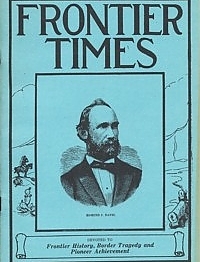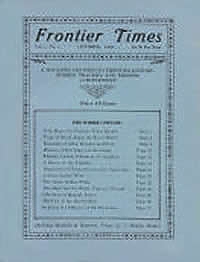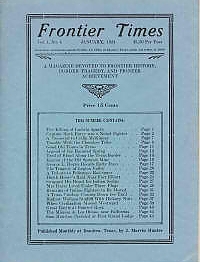By using our website, you agree to the use of cookies as described in our Cookie Policy
Magazines & Instant Downloads
Vol 07 No. 11 - August 1930
The End Of Carpet-Bag Rule In Texas
Edmund J. Davis was a native of Florida, and came to Texas in 1846. During Carpet-bagger rule of Texas, he was elected Governor January 18, 1870, and held the office until January 13, 1874. On January 19, 1874, he vacated the office and this made way for the installment of Governor Coke and the end of carpet-bag rule in Texas. This is the historical account. Mentions: Richard B. Hubbard * Richard Coke * General Reynolds
THE SEVEN CITIES OF THE CILOBA
Donald. F. MacCarthy
The Seven Cities of the Ciloba, if their legend be true, lie deeply buried beneath a flow of lava and volcanic ash some miles to the westward of Albuquerque, New Mexico, and were there builded on a once beautiful plateau, or high plain, overlooking the waters of the Rio Grande, far to the eastward, and facing the rising sun. Their destruction, with that of many of their people, occurred long years before the coming of Coronado.
Dr. Hoyt, Panhandle's First Doctor
By Fred E. Sutton
Account of Dr. Henry F. Hoyt, frontier adventurer and was the first physician to settle in the Texas Panhandle.
Further Mentions: Mrs. George Wilson * Frank B. Kellogg * Jim East's saloon in old Tascosa * Valley and Chilton * Len Woodruff * "Catfish Kid" Bozenman and King * Wayne Brazill * Joe E. McMasters, George Howard * W. H. BONNEY * Jack Ryan's saloon * Captain Jink's dance hall * the L. I. T. ranch, owned by the estate of Lee Bivins *
FIRST REAL HIGHWAY IN NEW WORLD
By N. H. Hunt
Account of Old Presidio Road, a trail that was laid out by usage and necessity from a point on the Rio Grande about 30 miles below Eagle Pass, to San Antonio and on Northeast through the Nacogdoches and St. Augustine country to Louisiana. This is the account of that historical highway.
Further Mentions: St. Dennis * Carrizo Springs in Dimmit * Loma Vista in Zavala * Old Frio. Town in Frio County * the Devine country * Morfi's diary of 1778 * Cotulla * Hinds * Winter Garden District * Espantosa Lake in Dimmit County * Bonito Juarez * Camino Real *
Old Military Posts Of The Southwest
By Col. C. C. Smith, U. S. A. Retired
THIS IS THE SECOND part of Old Military Posts of the Southwest, covering New Mexico, Colorado, Arizona and California, the first part (Texas) having appeared in the June issue of Frontier Times. Some Old Posts of New Mexico mentioned:
Fort Baker. * Fort Barclay. Near Fort Union * Fort Bascom * Fort Bayard * Camp Blake * Fort Thorn * Benjamin Cantonment * Lieut. J. H. Whittlesey * Fort Caniby, on Rio Pueblo Colorado * R. S. Canby * Fort Connelly. On the Rao Grande * Henry Connelly * Camp Conrad * Jornado del Muerto * Valverde * Fort Craig, originally Camp Conrad * Lt. Col. L: S. Craig * Mr. John R. Bartlett * Fort Cummings at Cook's Mountain Springs * Genl. J. H. Carletoni * Fort Fauntleroy * the A. T. & S. F. R. R. * Ft. Fauntleroy, became Fort Lyon then Fort Wingate * Thos. T.. Fauntleroy * Fort Fillmore, near Mesilla * Fort McLane, fifteen miles south of the old Santa Rita del Cobre copper mine * Camp Loring, got far from, Taos * Fort Lowell, on Chama river * Fort Plummer. * Fort Marcy * Wm. L. Marcy, * Genl. S. W.Kearny * Camp Magoffin * Fort McRea * Captain Alexander McRea * Ojo del Muerto * Fort Selden, nine miles from Dona Ana * Captain Selden * Fort Stantorx under El Capitan Mountain in Central New Mexico * Captain Henry W. Stanton, 1st Dragoons * 'Fort Summer in Guadalupe county, at the Bosque Redondo * Brig. Genl. James H. Carleton * Genl. E. V. Summer * Fort Union, at the base of the Gallinas Mountains in- Northeastern New Mexico * Camp Vigilanes, near Albuquerque * Fort West, at the headwaters of the Gila river * Col. J. B. West * Fort Lyon, thirty miles down the Arkansas river from Old Fort Ben * Brig. Genl. Nathaniel Lyon * Fort . Lewis, at Pagosa Springs, San Juan river * Fort Reynolds, eighteen miles east of the present city of Pueblo * General J. F. Reynolds * Fort Garland, in the Sierra Blanca Mountains in Southern Colorado * Captain Thomas Duncan * Col. John Garland * canyon of the Rio de los Yutas * Fort Massachusetts, six miles north of Fort Garland * Fort Apache, in the White Mountains * Major General G. H. Thomas * Fort Arivaypa, at the junction of Arivaypa Creek with the San Pedro river * Fort Breckenridge * Fort Grant under Mt. Graham, twenty-four miles from Willcox on the S. P. R. R * Fort Barrett, at the Pima Villages * Lieut. Jas. Barrett * Fort Buchanan, between Elgin and Patagonia * President Buchanan * Camp Crittenden * Lieut. Col. Crittenden * Camp Canyon de Chelly, in Canyon de Chelly * Col. Kit Carson * Camp Cameron, fifteen miles northeast of Tubac * Simon Cameron * Camp Date Creek, sixty miles southeast of Prescott * General McPearson * Fort Defiance, in Canyon Bonita in Apache county * Camp El Dorado, on Colorado river, near mouth of El Dorado Canyon * Fort Goodwin, on Goodwin Wash north of Fort Grant near Mt. Graham * J. N. Goodwin * Fort Huachuca, at the mouth of Huachuca Canyon. * Camp Hualpi, on Mojave Creek * Camp Pinal, near Pinal Mountains * Camp Lincoln, also called Fort Verde, on Verde river * Camp La Paz, on Colorado river * Fort Lowell, first (1866) at Tucson; then seven miles east of that city * Col. C. P. Lowell * Fort McDowell, on Verde river, eight miles above its junction with Salt river * Genl. Irvin McDowell * Camp McKee, first called Camp Mason, twelve miles southeast of Tubac at what is now Calabasas * Prescott Barracks, later called Whipple Barracks * Camp Rawlins, in Williamson Valley * General John A. Rawlins * Camp Reno, in Tonto Valley * General Jesse L. Reno * Camp J. A. Rucker, on White river * Camp Supply * Lieut. J. A. Rucker * Camp Walleu, on Babocomari Creek not far from Fort Huachuca * Major Henry D. Wallen * Fort Thomas, on the Gila River * General G. H. Thomas * Camp Drum, near San Pedro * Col. R. C. Dunn * Drum Barracks, near Wilmington * Drum Barracks, at San Diego * Camp Fitzgerald, near Los Angeles * Fort Moon, at Los Angeles * Fort Tejon, near Tejon Pass in Kern county * Fort Yuma, on Colorado river opposite the mouth' of the Gila river *
Colonel J. H. Faubion Passes On
Account of Colonel J. H. Faubion, pioneer Texan, honored citizen, soldier, patriot, statesman.
Mentions: his home in Leander * the Williamson County Sun, published at Georgetown * Rev. Gribbe of Austin * He was captured at Fort Donaldson, Tenn., and was transported to Camp Morton as a prisoner of war * Faubion was married to Miss Margaret Carolina Mason, daughter of Mr. and Mrs. C. C. Mason, Sr., * E. M. Faubion * Mrs. Mary Lelia McBride * Miss Katie McSween Faubion * Miss Lola Sophronia * Miss O. A. Faubion, Temple * Miss Maud Faubion, Leander * Judge Sidney Seymour * operated newspapers at Liberty Hill, Leander and Marble Falls * the Williamson County Historical Association * Col. W. K. Makemson *
Independence Declaration Put On View
Mentions: Mrs. Jane Y. McCallum * Dr. Thomas P. Martin * H. S. Kimble * William H. Wharton * Thomas S. Henderson of Cameron * Judge Sheppard * Senator Morris Sheppard * Richard Ellis * Charles B. Stewart, Thomas Barnett, James Collinsworth, Edwin Waller, Asa Brigham, John , S. D. Byrol. Franco Ruis, J. Antonio Navarro Jesse B. Badgett, Wiliam D. Lacey, William Menefee, John Fisher, Matthew Caldwell,. William Motley, Lorenzo de Zavala, Stephen H. Everitt, George W. Smith,. Elijah Stapp, Claiborne West, William B. Scates, M. B. Menard. A. B. Hardin, J. B. Bunton, Thomas J. Gazley, R. M. Coleman, Sterling C, Robertson, George C. Childress, Bailey Hardeman, Rob Potter, Thomas Jefferson Rusk, Charles Taylor, John S. Roberts, Collin McKinney, Robert Hamilton, James Power, Sam Houston, David Thomas, Edw. Conrad, Martin Farmer, Edwin LeGund, Stephen W. Blount, James Gaines, William Clark, Jr., Sydney 0. Pennington, William Carrot Crawford, John Turner. Benjamin Briggs Goodrich, William P. Carson, G. W. Barnett, James G. Swisher, Jesse Grimes, S. Rhoades Fisher, John W. Moore, Saniuel A. Maverick, John Bower, A. Briscle and J. B. Woods. *
The Adventures Of Big Foot Wallace
By John C. Duval. First Published in 1870 (Continued from last month)
This is the Fourth of a fifteen-part installment series of this quintessential Texan hero, frontiersman, Indian fighter, soldier, patriot and Mier captive. Duval does a masterful job capturing the character and uniqueness of the man and advantageously borrows heavily from Wallace’s own personal diaries, quoting from them at length. Wallace, from the old Scottish hero-heritage of the Wallace and Bruce clan, carried his noble blood to many escapades of which the history of the great state of Texas will forever be grateful and stands proud to call him one of her own sons. We can supply you with the rest of this great series – just email us for details.
The Famous Ku Klux Klan
By Thomas Dixon, Jr.
The Ku Kluz Klan was a great law and order league of mounted night cavalrymen called into action by the intolerable conditions of a reign of terror under negro rule in the South. It was the answer to their foes of an indomitable race of men, conquered, betrayed, disarmed and driven to desperation. It was the old answer of organized manhood to organized crime masquerading under the forms of government…
Its rise was due to the mind of no leader. It was an accident. It was a case of spontaneous combustion…A group of college boys at Pulaski, Tenn., organized it first as a local college fraternity. They found a name in … and lo, the awe-inspiring "Ku Klux Klan!"
The terror of these silent ghosts, riding in the night, reduced the negro race to an immediate and profound peace: The idea spread to an adjoining county and rapidly over the State of Tennessee, which was the first to pass beneath the yoke of negro supremacy.
In 1867 a secret convention of peaceloving, law-abiding, God-fearing, patriotic Southerners met in Nashville and organized this society into "The Invisible' Empire."
Within a few months this empire had overspread a territory larger than modern Europe, and brought order out of chaos…
…Thieves looted the treasury of every State and county and taxes mounted until as many as 2900 homesteads of white men, many of whom could not vote, were sold for taxes in a single county…
The lengthy and detailed article goes on to recount the developments and activities of the group through the post Civil-war days in particular.
Mentions: Thaddeus Stevens * the secret oathbound order known as "The Union League." * John C. Fremont * Judge Albion W. Tourgee * Governor Holden * Colonel Leray McAfee * General Nathan Bedford Forrest of Tennessee * Engwizard * McAlpin and Ferguson * George Gordon * John B. Gordon, of Georgia * Rev. Thomas Dixon, Sr * Lieutenant Colonel Frederick Hambright * the battle of Kings Mountain * Rev. Dr. J. A. Clifton * Dr. Bratton * Mr. Laps. D. McCord of Tennessee * John W. Morton * General George W. Gordon of Memphis * Dr. Landrum * The order of dissolution of the Klan as issued by General Forrest * Matt N. Brown, a gallant clansman *
"PIONEER WOMEN IN TEXAS"
Mentions: the E. L. Steck Company of Austin, Texas * Mrs. Annie Doom Pickrell * Mrs. Martha A. Vaughn and Mrs. J. A. Winn early settlers of Menard county *
BILLY THE KID'S CAPTOR DEAD
Account of James H. East. Mentions: * East was born in St. Louis Aug. 30, 1853. Seventeen years later, he was a Texas cowboy, learning the rough life of the cattle range and schooling himself in the use of the revolver, a trade of those early days so well learned that when Garrett came to organize his forces to fight the "Kid," he brought East from Texas and made him one of the posse. * Gen. Lew Wallace * served for four years as sheriff of Oldham County * Miss Hattie Boulding * the Lee-Scott Cattle Company *
HOW LLANO CAME INTO ITS OWN
This article is written by a great grandniece of the Oatman family, Mrs. A. C. Bowman, of Llano. The article is of interest to many people of this section. It describes how "Llano County, which was formed out of Gillespie County and the original municipality of Bexar, derived its name from the river which divides the town, and which begins in the great plains now known as Schleicher and Sutton Counties," Mrs. A. C. Bowman of that city said. "The Spaniards called the river `Llano,' or the `plains.' Thus the county's name.
"Although the county proper was organized in 1856, Llano had its real beginning in the early 40's, when members of the ,German colonies that first settled in and around Fredericksburg moved on the wide-open Llano country, where there was plenty of wild game, fish, cheap land and numerous springs and creeks.
"There is a tradition that in the early days the first inhabitants of the county were highwaymen, banded together in what was called the "Tree Society," so named for a penalty which called for hanging on the limb of a tree any member who failed in his obligation to the society. Be that as it may, the first substantial settlers, according to records, were Germans…
Further Mentions: settlers on the Llano River near Castell * Colorado River near Bluffton * Valley Springs * Pack Saddle, Mountain * Clement Oatman, great-uncle of Wilburn Oatman, attorney of Llano * In 1853 the population of ' Llano County was about 1,000
Texas Keeps Faith With Her Forebears
Details the efforts of Lou Kemp, a keen student of Texas history who began to investigate and found to his surprise that many famous Texans were lying in unmarked graves in abandoned family cemeteries, scattered all through the southern portion of the State. His work is documented in this article.
Mentions: General Edward H. Tarrant, a noted Indian fighter and jurist, and the man from whom Tarrant County received its name * the Tarrant plantation * the Daughters of the Republic of Texas * Edwin Waller, a signer of the Texas Declaration of Independence and the man who had charge of building the first capitol of Texas at Austin, in 1839 * the Waller family cemetery in Waller County * Governor Dan Moody * Governor Peter Hansborough Bell * Judge Robert M. Williamson, "Three-Legged Willie' * Jesse Billingsley, captain of a company at San Jacinto * Robert Potter * Caddo Lake in Marion County * Oliver Jones, chairman * Hardin R. Runnels * Royal T. Wheeler * John E. Greer * Robert M. Williamson * James Pinckney Henderson * Lou Kemp Highway *
Our Greatest Heritage From First Americans
Lewis Sowell
This story describes the single most valuable commodity the white settlers in the west were ever to gain from the Indian culture. The story is convincing and enlightening.
Fourth Cavalry Has Lived Up To Its Motto
THE 4TH CAVALRY was organized in 1855 as the, 1st Cavalry, its designation as the 4th being made six years later. In August, 1855, its personnel was assembled at Jefferson Barracks, Missouri, from active recruiting taken throughout various parts of the country. This is it’s history.
Mentions: General Wilson * Colonel Ronald S. Mackenzie * the village of Dull Knife * etc, etc, etc
A Cowboy Of The Guadalupes
By Mrs. B. E. Pedrick
Account of the life of George Jayroe, who opened cattle range around the Davis and Guadalupe Mountains.
Mentions: His camp was about one mile from the foot of the mountains, near Pine Springs * the head of Black River, down the Pecos as far as Pecos City, through the Davis Mountains * He bought his supplies and received his mail at Toyah, Texas, a little town on the Texas & Pacific Railroad, eighty miles from his camp * the head of Black River
"By this time George, too, had a sinister feeling and some instinct prompted him to head back toward camp. He had not ridden far when he was aware of a mighty calmness that had settled all over the land. It was the calmness and stillness of death. As far as he could see he saw • the cattle gathered together in silent bunches, their heads in the air and their noses pointed toward the north. He looked out to the north and east and saw a great …
Pioneer Life In Fredericksburg
By Esther Mueller
MRS. GOTTLIEB BURRER, (Katherina Zammert), came to Fredericksburg with the first settlers in May 1846. When she first saw the spot that is now Fredericksburg, the country was only wilderness, covered with rank weed and grass, waist high to a man.
The freighters of the ox carts, having fulfilled their contract and brought the colonists to Fredericksburg, dumped, the colonists and their possessions upon the ground, and left them.
The Zammert family, with the others pitched camp under the open sky. One morning a rattle snake crawled across the pallet upon which Katherina Zammert had been sleeping. Katherina, then three years old, was ready to grasp the snake, when her father killed it with a stone.
Her father, Daniel Zammert, having built a log house that was fairly rainproof, went to San Antonio to work until he had enough money to buy a cow. But he had been in San Antonio only a month before he fell victim to the cholera. A few weeks later the eldest sister also died of the cholera.
The Zammert family lived through the starvation days in the colony, when no freight wagons came with provisions for the colonists. They suffered from want of food, but Mrs. Burrer remembers that her mother was careful not to prepare greens for the table unless she was familiar with them. At this time many of the colonists died from eating poke berry root, and a poisonous wild spinach…
Further Mentions: the residence of Adolf Gold * the Verein's Kirche * Frank Vander Stucken * Her sister, Minna, Mrs. Heinrich Langhennig * Mrs. Louis Klaerner *
Mrs. Burrer was present at the founding of Fredericksburg. She has seen it grow from a settlement in the wilderness, into a city with a population of several thousand. The hardships she endured as a pioneer have taught her the value of food and clothing.. Many of the conveniences of modern life, which are regarded as necessities she knows as luxuries. When she hears complaints of hard times, she says, "Dann fuchle ich als ob ich sprechen muss!"
Montague County Abounds In Wealth Of Indian Lore
By Vera V. Thomas
Here is some excellent early history of the old historic town of Saint Jo, TX and of Montague County. Mentions: an old, old graveyard, where the first residents of the town of Saint Jo and a number of Indians are buried. * Dove Bellah who moved to Montague County in 1873 * the town consisted of a few houses and two saloons * are Dr. J. D. Crump,, J. H. Boggess, Parson Phillips and Dove Cunningham * The first store selling general merchandise was put up about 1890 by Mr. Bellah in one of the old saloon buildings * The town was laid off by Joe Howell * Sherman * Denison * the Indians and their famous stronghold northeast of the city. * the Devil's Backbone * Giles Gordon * Gordon's Pass * Tyler's Bluff * a white man named Tyler * the old Montague road west of Saint Jo * the present town of Sunset on Brushy Creek, in the northwestern part of the county * Mr. G. K. Martin of Granger, Texas; Mr. Starr Bryden of Kerrville, Texas, and Mrs. W. F. Bickenbach of Mason, Texas
$4.95
‹ Back








